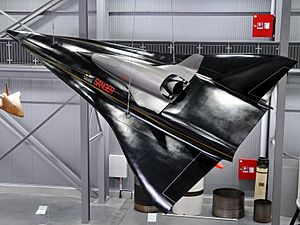Eugen Sänger facts for kids
Quick facts for kids
Eugen Sänger
|
|
|---|---|
 |
|
| Born | 22 September 1905 Preßnitz, Bohemia
|
| Died | 10 February 1964 (aged 58) |
| Nationality | Bohemian, Austrian |
| Occupation | Engineer |
| Spouse(s) | Irene Sänger-Bredt |
| Engineering career | |
| Significant advance | lifting body and ramjet |
Eugen Sänger (born September 22, 1905 – died February 10, 1964) was an Austrian aerospace engineer. He is best known for his important work on lifting body designs and ramjet engines. These technologies help aircraft fly faster and more efficiently.
Contents
Early Life and Rocket Dreams
Eugen Sänger was born in a town called Preßnitz, which was part of the Austro-Hungarian Empire at the time. He first studied civil engineering at universities in Graz and Vienna.
While he was a student, Sänger read a book by Hermann Oberth called Die Rakete zu den Planetenräumen. This book was all about rockets and space travel. It inspired Sänger so much that he decided to switch his studies to aeronautics, which is the science of flight. He even joined a German group of amateur rocket enthusiasts called the Verein für Raumschiffahrt (Society for Space Travel).
Sänger wanted to write his university thesis about rocket-powered flight. However, his professors thought his ideas were too imaginative and rejected it. He later graduated by writing about a simpler topic. But Sänger didn't give up on his rocket ideas. In 1933, he published his rejected thesis as a book called Raketenflugtechnik ("Rocket Flight Engineering").
Around this time, in 1928 and 1929, a group called Opel RAK had already made the world's first manned rocket planes. One of these, the Opel RAK.1, was flown by Fritz von Opel in front of many people.
Sänger continued to publish articles about rocket flight in an Austrian journal. These articles caught the eye of the German aviation ministry. They were interested in his ideas because they wanted to build a bomber plane that could reach the United States from Germany. This project was known as the Amerikabomber.
The ministry gave Sänger a research center near Braunschweig. They also built a special plant for liquid oxygen and a test stand for a very powerful rocket engine.
The "Silverbird" Space Plane
In 1936, Sänger began leading a rocket development team. He started to imagine a special rocket-powered plane. This plane would be launched by a sled and then use its own rocket engines to climb to the edge of space. Instead of going into orbit, it would skip along the upper atmosphere like a stone skipping on water. This way, it could travel huge distances.
This amazing design was called the Silbervogel ("Silverbird"). It was designed to use its body shape to create lift, helping it glide along its path. Sänger worked on this design with Irene Bredt, a mathematician who later became his wife.
Sänger also designed the powerful rocket engines for the Silbervogel. These engines would need to produce a massive amount of thrust. He was one of the first to suggest a clever way to cool the engine: by circulating the rocket fuel around the engine nozzle before burning it. This would keep the engine from overheating.
By 1942, the aviation ministry decided to focus on technologies that were already proven. So, the Silbervogel project was stopped. Sänger then worked on ramjet technology until the end of World War II.
After the War
After World War II, Sänger worked for the French government. In 1949, he helped create the Fédération Astronautique, an organization for space travel.
During his time in France, there was an attempt by Soviet agents to convince him to move to the Soviet Union. The Soviet leader, Joseph Stalin, was very interested in the Silbervogel design. But Sänger did not go.
In 1951, Sänger became the first President of the International Astronautical Federation. In the same year, he married Dr. Irene Sänger-Bredt, who had been his assistant and helped design the Silbervogel.
By 1954, Sänger returned to Germany. A few years later, he was in charge of a jet propulsion research institute in Stuttgart. From 1961 to 1963, he advised the company Junkers on designing a ramjet-powered space plane. This project, however, was never built.
Sänger also came up with other futuristic ideas. He suggested using photons (tiny particles of light) for powering spacecraft that could travel between planets or even to other star systems. These ideas were early versions of concepts like laser propulsion and the solar sail.
In 1960, he helped the United Arab Republic develop a missile called the Al-Zafir.
Eugen Sänger passed away in Berlin in 1964. His work on the Silbervogel was very important. It influenced later projects like the North American X-15, the X-20 Dyna-Soar, and eventually the Space Shuttle program.
Honours and Recognition
Eugen Sänger was an honorary member of many societies for Space Research around the world.
- He was made an Honorary Fellow of the British Interplanetary Society (B.I.S.) in 1949.
- He received the Hermann Oberth Medal for his contributions to aerospace research.
- He was awarded the Austrian Cross of Honour for Science and Art, 1st class.
- He received the Commander of the Ordre du Merite pour la Recherche et l'Invention from Paris.
- He was given the Gagarin Gold Medal from the Assoziazione Internazionale Uomo nello Spazio in Rome.
- He also won a Gold Medal at the Milan Fair.
- A street in Vienna, called Sängergasse, was named after him in 1971.
See also
 In Spanish: Eugen Sänger para niños
In Spanish: Eugen Sänger para niños
- Keldysh bomber
- Laser propulsion
- Silbervogel
- Spacecraft propulsion



